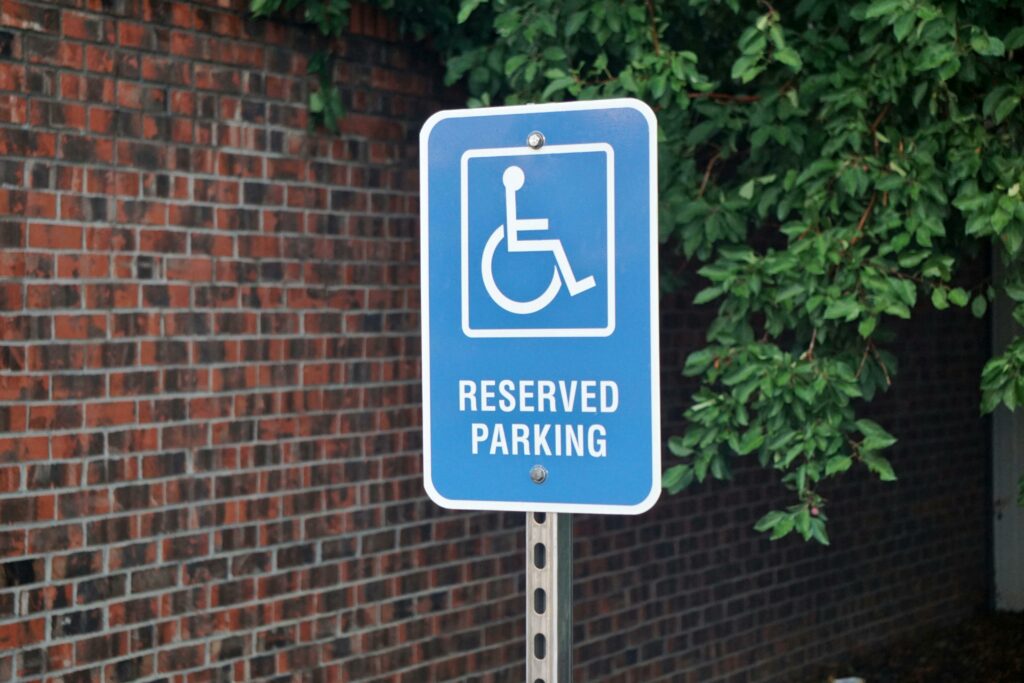Understanding the law and your right to use a disabled parking sign can considerably simplify your life or that of someone you look after. In this article, we break down everything from the symbolism behind the wheelchair parking sign to legal requirements outlined in the blue parking sign.
We’ll also look into the specifics of the accessible parking sign and the reserved parking sign, ensuring you’re fully equipped to navigate any disabled parking lot sign. This is your one-stop resource for mastering the often-confusing world of mobility parking signs, disabled parking space signs, and more.
Importance of a Disabled Parking Signs
Understanding the importance of disabled parking signs is vital for everyone in the community. These signs show empathy, respect, and ensure compliance. They communicate essential parking rules reserved for people with disabilities, making their lives easier and more independent.
Disabled parking signs designate spaces for people with disabilities or mobility impairments. Often marked with a wheelchair symbol, they ensure accessibility in car parks. This supports equal access to public spaces and reduces physical obstacles for those with limited mobility. Schemes like the Disability Parking Scheme in NSW further support these goals by providing those with disabilities easier access to essential facilities.
Disabled parking signs send a clear message: respect the rights of people with disabilities. Without them, those with disabilities face unnecessary difficulty, undermining their comfort, convenience, and independence.
Ignorance or intentional disregard of these signs leads to undue strain and difficulty, making it even more critical for society to comprehend the importance of a disabled parking sign. These represent more than a parking regulation, but a societal commitment to upholding equality, respect, and inclusivity, thus playing a significant role in the daily lives of many.
The Significance of the Wheelchair Symbol in a Disabled Parking Space Sign
The wheelchair symbol, also known as the International Symbol of Accessibility (ISA), is a key element of a disabled parking sign. It serves a vital role in conveying the purpose of the parking space – that it is reserved exclusively for the use by individuals with disabilities.
Often depicted in white against a blue background, the wheelchair symbol is universally recognised. Its presence on a disabled parking sign not only dramatises the sign’s visibility but also underscores the significance of providing accessible parking options for those with mobility restrictions. Indeed, the wheelchair symbol can be viewed as a testament to inclusivity, emphasising that persons with disabilities should have the same access to facilities, including parking, as everyone else.
Without the wheelchair symbol, a handicap parking sign may fail to command the same level of attention and respect. This image serves as a strong deterrent to misuse, reminding everyone that these spaces are not simply convenient parking spots but are essential for those with disabilities to access services and facilities.
Recognising this symbol’s importance is key for anyone who is a person with a disability, a carer for someone with a disability, or a support coordinator with disability clients. These stakeholders must understand the meaning behind the symbol to ensure their rights, and the rights of those they care for or represent, are respected and protected.
Deciphering the Colours: The Meaning Behind a Blue Parking Sign
A blue card parking sign is universally recognised and used for designating parking spaces specifically meant for vehicles carrying people with disabilities. But what significance lies behind the colour blue used in this essential accessible symbol? Why not red or yellow? The answer lies in the uncomplicated, yet profound power of colours in regulating human behaviour.
Blue is widely employed for disability-related symbols due to its characteristics. It is a calming colour that commands trust, dependence and respect – traits that are vital for accommodating people with disabilities. The blue colour ensures the disability parking sign is highly noticeable, making it more effective in securing and governing these specially allocated spots in a seemingly crowded array. At the same time, blue is a passive colour that doesn’t spark frenzy or unrest. This allows it to effortlessly blend into various surroundings, simultaneously ensuring visibility without being obtrusive.
Moreover, the bold white wheelchair symbol against a blue background provides a stark contrast. This not only eases visibility but also reinforces inclusivity and respect for individuals with disabilities. With many global cultures associating the colour blue with freedom and ease, this parking sign is symbolic of the freedom of movement the person with a disability has in society.
In essence, the use of blue extends beyond pure practicality. It signals a welcoming and inclusive space. The calming color promotes a sense of consideration and respect, contributing to a more accessible environment for everyone.
When navigating through the busy communal spaces, the blue signage serves as a beacon of accessibility, promoting both practical help and a positive societal attitude towards our fellow citizens who live with a disability.
Key Aspects to Consider in a Mobility Parking Sign Placement
When it comes to the effective use of a disabled parking sign, placement can play as crucial a role as the sign’s design. Especially in places with high traffic, proper display of a mobility parking sign can significantly enhance its visibility and impact, ensuring that disabled persons can quickly and easily identify parking spaces designed for their use.
Firstly, the location of the handicap parking sign should be at a height where it is easily viewed by drivers. Disability parking guidelines prescribe mounting them at least 60 inches from the ground to the bottom of the sign. In busy parking lots, they should be positioned facing the flow of traffic for optimal visibility. In addition, these signs should not be placed in a way that obstructs pedestrian or vehicular pathways.
Secondly, for an accessible parking sign to fulfil its role effectively, it should clearly display the key features. The wheelchair symbol should be prominent enough to be seen from a distance. Also, if there are any specific conditions or restrictions related to the use of the parking space, they should be identified with supplementary signage.
Thirdly, the disabled parking lot sign placement should consider lighting. For lots operating at night, symbols and lettering should be retroreflective or illuminated to show up in the dark.
Additionally, the placement of disabled parking should be considered in conjunction with accessible vehicle technology. Spaces designated for individuals using assistive devices like wheelchair lifts or ramps may need extra clearance. Thinking proactively about these needs enhances accessibility for a wider range of people with disabilities.
Lastly, it’s paramount that reserves parking sign placements are regularly inspected for any damage or obstructions. Wear and tear, vandalism, or weather conditions could limit their visibility, potentially causing inconvenience for disabled drivers.
The positioning of a disabled parking sign is a crucial aspect of its effectiveness. Following these guidelines will help ensure that these crucial resources for disabled individuals are evident and reachable, thereby promoting mobility, independence, and quality of life for individuals living with disabilities.
Legalities Surrounding the Use and Misuse of a Disabled Parking Lot Sign
The use and misuse of a disabled parking sign are governed by various legal regulations to maintain fairness and provide essential convenience to individuals in need. Violations regarding the inappropriate use of these signs often result in hefty fines or potential litigation.
The primary purpose of a disabled parking lot sign, also known as a handicap parking sign, is to reserve these spaces for individuals who hold a valid parking permit due to their disability. These permits are usually issued by the relevant local authorities and must be displayed visibly when parking in these reserved spots. It is unlawful to park in a space designated by a disabled parking sign without possessing a valid permit. In some areas, this misuse can also include parking a vehicle outfitted for a wheelchair user if the individual in question is not present.
It’s also worth noting that each jurisdiction may have distinct requirements and regulations about accessible parking signs. While these parking sign standard is widely accepted in the United States, other countries use different symbols and may have specific rules about the appropriate signage. Despite these distinctions, the general principle that these signs are exclusively for disabled individuals’ use remains consistent globally.
Furthermore, businesses offering parking facilities are generally obliged by law to provide a certain number of disabled parking spaces, usually indicated by a disabled symbol sign. They must ensure the signage is clear and conforms to the systematic standards for it to be considered an appropriately designated disabled parking space sign.
Not only does misuse of these spaces cause inconvenience for disabled individuals who genuinely need them, but it also displays a lack of respect and understanding. Hence, staying informed about the legislation pertaining to the disabled parking sign is crucial for everyone. Awareness and compliance with these rules and regulations can help to foster an inclusive society that respects and facilitates individuals with disabilities.
Applying the Disabled Parking Sign Guidelines
The significance of a disabled parking sign cannot be overstated. They provide necessary access to buildings and facilities for persons with disabilities. Knowledge about the distinct features of the disabled parking sign, including the universally recognisable wheelchair symbol and the indication of reserved spaces through a blue sign, is essential for everyone to understand and respect these spaces. It is equally important to be aware of the key aspects to consider in sign placement, ensuring maximum visibility and accessibility for disabled individuals.
Abuse and misuse of these signs are unlawful and deny rightful users their access rights. Therefore, respecting the purpose and use of disabled parking signs is a collective responsibility. Let this information empower you as an individual with a disability, a carer or a support coordinator, to seek correct implementation of these signs and call out any misuse or misrepresentation. Understanding these signs is the first step towards an inclusive society.
Disabled Parking Sign FAQs
1. What is a disabled parking sign?
A disabled parking sign is a sign that indicates a designated parking space for people with disabilities. It is commonly placed in parking lots or areas to reserve parking spaces specifically for individuals with disabilities.
2. What are the design features of a disabled parking sign?
A disabled parking sign typically features the international symbol of access, which is a wheelchair symbol on a blue background. It may also include additional text indicating that the space is reserved for individuals with disabilities, such as “Disabled Parking Only” or “Accessible Parking.”
3. Where should a disabled parking sign be placed?
A disabled parking sign should be placed at the entrance of a designated parking space for people with disabilities. The sign should be clearly visible and easily readable to ensure that other drivers are aware of the reserved nature of the space.
4. What are the regulations surrounding the use of a disabled parking sign?
The use of a disabled parking sign is regulated to ensure that parking spaces for individuals with disabilities are properly reserved and accessible. These regulations may vary depending on the country or region, and it is important to comply with the specific rules and requirements in your area.
5. Can I use a disabled symbol sign without proper authorization?
No, it is not permitted to use a disabled symbol sign without proper authorization. The use of a disabled parking sign is reserved for individuals with disabilities who have a valid disabled parking permit or license plate. Unauthorized use can result in fines or penalties.






 James
James 

